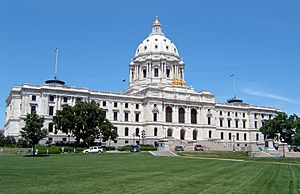Government of Minnesota facts for kids
Minnesota is governed pursuant to the Minnesota Constitution, which was adopted October 13, 1857, roughly one year before statehood. Like all U.S. states and the federal government, Minnesota has a republican system of political representation with power divided into three branches: executive, legislative, and judicial. The state constitution includes a bill of rights that reaffirms many of the same rights and freedoms as its federal counterpart, with some protected more strongly and explicitly.
Executive

The executive branch is headed by the governor, currently Tim Walz, DFL (Democratic–Farmer–Labor), who took office on January 7, 2019. The governor has a cabinet consisting of the leaders of various state government agencies, called commissioners. The other elected constitutional offices are secretary of state, attorney general, and state auditor.
Constitutional officeholders:
- Governor Tim Walz (DFL)
- Lt. Governor Peggy Flanagan (DFL)
- Secretary of State Steve Simon (DFL)
- Attorney General Keith Ellison (DFL)
- State Auditor Julie Blaha (DFL)
Legislature

The Minnesota Legislature is a bicameral body consisting of the Senate and the House of Representatives. The state has 67 districts, each with about 60,000 people. Each district has one senator and two representatives, each senatorial district being divided into A and B sections for members of the House. Senators serve for four years and representatives for two years.
Since 2023, both the House and Senate have had a slim DFL majority.
Judiciary
Minnesota's court system has three levels. Most cases start in the district courts, which are courts of general jurisdiction. There are 279 district court judgeships in ten judicial districts. Appeals from the trial courts and challenges to certain governmental decisions are heard by the Minnesota Court of Appeals, consisting of 19 judges who typically sit in three-judge panels. The seven-justice Minnesota Supreme Court hears all appeals from the tax court, the workers' compensation court of appeals, first-degree murder convictions, and discretionary appeals from the court of appeals; it also has original jurisdiction over election disputes.
Two specialized courts within administrative agencies have been established: the workers' compensation court of appeals, and the tax court, which deals with non-criminal tax cases.
Supreme Court Justices
- Chief Justice Lorie Gildea
Associate Justices
- Barry Anderson
- David Lillehaug
- Natalie Hudson
- Margaret Chutich
- Anne McKeig
- Paul Thissen
Regional
In addition to the city and county levels of government found in the United States, Minnesota has other entities that provide governmental oversight and planning. Regional development commissions (RDCs) provide technical assistance to local governments in the broad multi-county areas of the state. Along with this Metropolitan Planning Organizations (MPOs), such as the Metropolitan Council, provide planning and oversight of land use actions in metropolitan areas. Many lakes and rivers are overseen by watershed districts and soil and water conservation districts.
Federal
Minnesota's United States senators are Democrats Amy Klobuchar and Tina Smith. The state has eight congressional districts; they are represented by Brad Finstad (1st district; R), Angie Craig (2nd; DFL), Dean Phillips (3rd; DFL), Betty McCollum (4th; DFL), Ilhan Omar (5th; DFL), Tom Emmer (6th; R), Michelle Fischbach (7th; R), and Pete Stauber (8th; R).
Federal court cases are heard in the United States District Court for the District of Minnesota, in Minneapolis, St. Paul, Duluth, and Fergus Falls. Appeals are heard by the Eighth Circuit Court of Appeals in St. Louis, Missouri and St. Paul.
Tribal
The State of Minnesota was created by the United States federal government in the traditional and cultural range of lands occupied by the Dakota and Anishinaabe peoples as well as other Native American groups. After many years of unequal treaties and forced resettlement by the state and federal government, the tribes re-organized into sovereign tribal governments. Today, the tribal governments are divided into 11 semi-autonomous reservations that negotiate with the U.S. and the state on a bilateral basis:
Four Dakota Mdewakanton communities:
- Prairie Island Indian Community
- Shakopee Mdewakanton Sioux Community
- Lower Sioux Indian Reservation
- Upper Sioux Community – Pejuhutazizi Oyate
Seven Anishinaabe reservations:
- Bois Forte Band of Chippewa
- Fond du Lac Band of Lake Superior Chippewa
- Grand Portage Band of Chippewa
- Leech Lake Band of Ojibwe
- Mille Lacs Band of Ojibwe
- White Earth Band of Ojibwe
- Red Lake Band of Chippewa
The first six of the Anishinaabe bands compose the Minnesota Chippewa Tribe, the collective federally recognized tribal government of the Bois Forte, Fond du Lac, Grand Portage, Leech Lake, Mille Lacs, and White Earth reservations.


